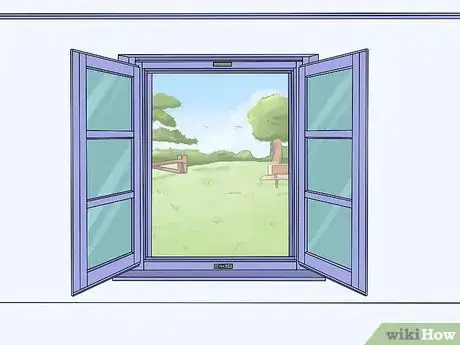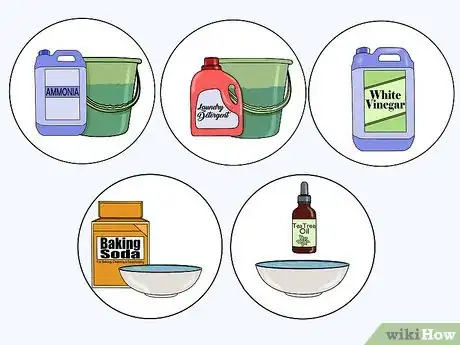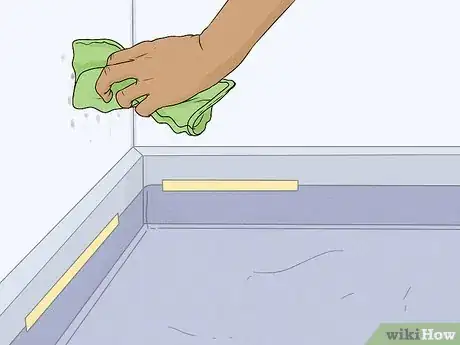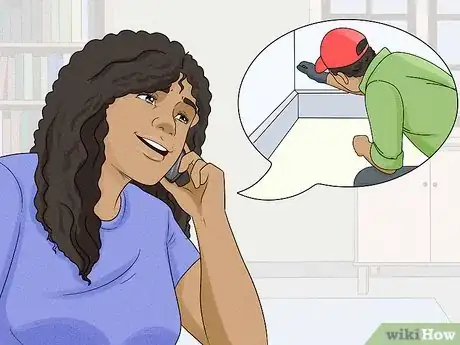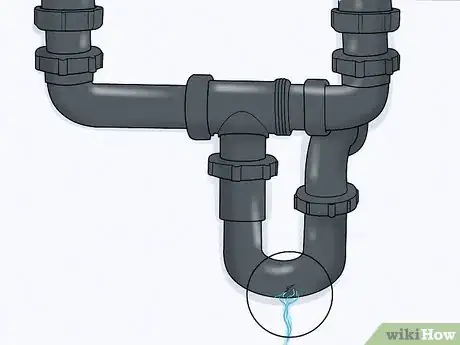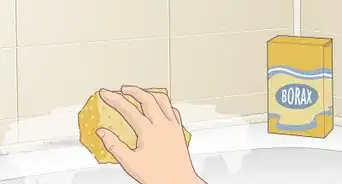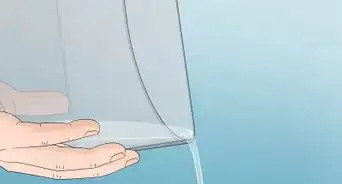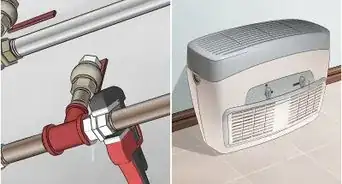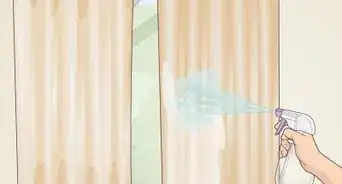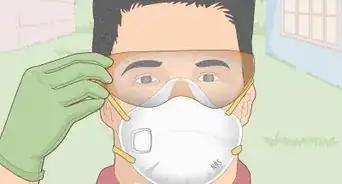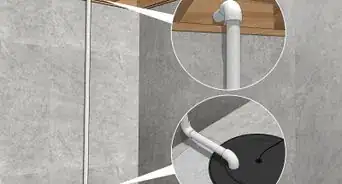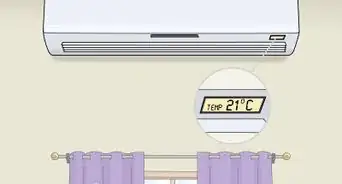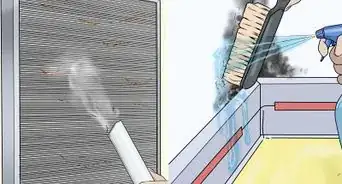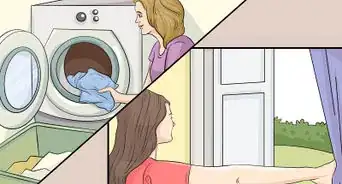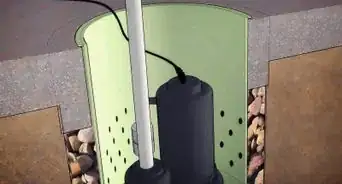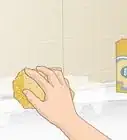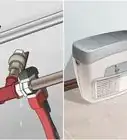This article was co-authored by Mike Kapur. Mike Kapur is a home inspector and the owner of Sonic Home Inspections, a home inspection company in Westchester, New York. With over 15 years of experience in pre-inspecting properties, Mike specializes in mold, radon, asbestos, lead, water, and air quality testing as well as hazardous materials, pest, infrared, and general home inspections. Prior to founding Sonic Home Inspections, Mike worked pre-inspecting apartments. Mike holds a BS in Accounting from Queens College and is a Certified Mold Assessor in the state of New York.
There are 7 references cited in this article, which can be found at the bottom of the page.
wikiHow marks an article as reader-approved once it receives enough positive feedback. This article received 22 testimonials and 84% of readers who voted found it helpful, earning it our reader-approved status.
This article has been viewed 1,310,011 times.
Black mold is a type of fungus that can grow indoors. Like all molds, black mold loves moist environments, so areas that are often damp, such as wet basements, showers, bathrooms, and areas where there's a leak, are prone to mold growth.[1] Because some kinds of black mold can cause allergic reactions, asthma attacks, and respiratory issues, it’s important to remove it when you do find it in your house. The trick to killing black mold is penetrating the mold and killing the roots as well as the surface mold, and taking steps to ensure it doesn’t return.
Steps
Taking Safety Precautions
-
1Identify black mold. Black mold often grows in damp areas, places that are often wet, or places where there has been a leak or water damage. Common places to find black mold include basements, crawl spaces, bathrooms, and laundry rooms. Here are a few of the identifying characteristics of black mold:[2]
- It appears black in color
- It grows in a circular pattern
- Patches of black mold look like they're made up of dots
- It looks slimy on a wet surface
- On a dry surface, it will look like soot
-
2Seal the area. To prevent mold spores from becoming airborne and spreading, you can seal the room. Put up sheets of plastic to cover doors and vents that lead to other areas of the house. Use painter’s or construction tape to tape the plastic in place and seal the room.[3]
- Vents you may want to cover include return vents, and heating and air conditioning vents. Leave exhaust vents open.
- Sealing the area will help prevent spores from spreading from one area of the house to another.
- Sealing won’t necessarily stop mold from growing elsewhere in the house. Mold spores are always present in the air, and mold can grow anywhere that there's moisture.
Advertisement -
3Open windows. Mold itself and the cleaning products you use to kill it can irritate eyes, skin, and lungs, so you must provide yourself with as much fresh air as possible. In the area where you're going to be attacking the mold, open as many windows as possible
- In winter when it’s cold out, open at least one or two windows to let in some fresh air.
-
4Turn on vents and fans. To help draw mold spores out of the room and out of the house, turn on any exhaust fans in the room you're working in. You can also position a fan in front of an open window and aim it outside. This will similarly draw mold spores out of the room and push them outside.
- To prevent blowing mold spores around the room, avoid using fans if they're not right in front of a window and blowing air outside.
-
5Wear personal protective equipment. Mold exposure can cause upper respiratory illness, and the cleaners you use to kill the mold may also be damaging and corrosive. To protect yourself while you're cleaning, consider wearing protective gear, including:[4]
- Safety goggles
- Non-porous gloves
- Mask or respirator
-
6Don’t mix cleaning solutions. You will have to choose a cleaning solution to kill the mold, and it’s important that you stick to that one cleaner. Mixing different cleaners can be very dangerous, and you can create unexpected chemical reactions.
- Never mix ammonia or bleach together or with any other household cleaners.
-
7Consider replacing absorbent materials. Removing mold from absorbent materials can be extremely difficult. Instead, most professionals will recommend that you remove and replace such items, since it probably won’t be possible to remove the mold without damaging the material or causing further problems.[5]
- Absorbent materials that may need to be replaced include drywall, ceiling tiles, furniture and carpeting.[6]
Cleaning Affected Areas
-
1Scrub the affected area with soapy water. Fill a bucket with warm water, and add 2 tablespoons (30 ml) of liquid dish soap. Swish the soap around in the water to make suds. Dip a stiff-bristled brush into the soapy water and scrub the moldy surface with the brush.[7] Re-dip the brush regularly and scrub until the area is saturated with suds. Rinse the area with water.
- Pre-scrubbing the mold will help break up the surface so that you can penetrate to the roots with your cleaner and kill the mold.
-
2Mix your cleaning solution. There are a number of cleaning solutions and products you can use to clean mold. The most effective will be a commercial biocide or antimicrobial cleaner, which is specifically designed to kill mold. There are other cleaning solutions you can try that have proven effective, including:
- Equal parts ammonia and water
- 1 cup (235 ml) of bleach mixed with 1 gallon (3.8 L) of water
- Pure distilled vinegar
- 1 teaspoon (5 ml) of tea tree oil and 1 cup (235 ml) of water
- Equal parts baking soda and water, mixed into a paste in a bowl
- One part hydrogen peroxide mixed with two parts water
- 1 cup (409 g) of borax dissolved in 1 gallon (3.8 L) of water
- ¼ cup (102 g) of borax dissolved in ½ cup (118 ml) of vinegar and 4 cups (940 ml) of warm water
-
3Apply cleaner and let it soak. For liquid solutions, spray generous amounts of cleaner on the moldy surface that you pre-scrubbed. For pastes, apply the paste to the affected area with a knife, brush, or old tooth brush.
- Let the cleaner stand for about 15 minutes. This will give it time to penetrate the mold and kill it all the way to the roots, which will prevent it from growing back.[8]
-
4Scrub porous materials. When the cleaner has had time to soak in, scrub the surface with a stiff-bristled brush. This will help dislodge the mold and work the cleaner in even farther.
- You can use an non-abrasive scrubbing pad to scrub the area as well.
-
5Rinse and dry the area. To remove any leftover mold and cleaner, rinse the area with clean water. When the mold and cleaner are gone, wipe the area dry with a towel or a squeegee. This will remove excess moisture and prevent the mold from growing back.[9]
- Mold can start growing on a damp surface within 24 hours, which is why it’s important to keep the area dry after cleaning.
-
6Know when to call a professional. Mold can be notoriously difficult to clean, especially in hard to reach places and on certain materials, such as dry wall and other porous materials. There are times when it’s best to call a mold removal professional, including if:[10]
- Your cleaning effort wasn’t effective
- The affected area is larger than 10 square feet (3 square meters)
- You suspect there's mold in your heating, cooling, or ventilation system
- You have any health concerns about the mold
- The mold problem was caused by contaminated water or sewage
Preventing Black Mold
-
1Remove the source of moisture.[11] As long as there's a moisture source, there's the potential for mold. After cleaning your mold problem, it’s essential that you remove the source of the moisture that caused the mold to grow in the first place.[12] Depending on where in the house the mold was, possible moisture problems could include:
- Leaks
- Floods
- Spills
- Dampness from cooking or bathing
- Lack of moisture barrier in the basement
-
2Lower the humidity. Mold thrives in humid environments where the moisture levels are above 50 percent. To prevent mold, install a hygrometer and keep and eye on the humidity levels. When it gets too high, ways to reduce humidity include:[13]
- Running a dehumidifier[14]
- Running the air conditioner
- Opening windows
- Increasing ventilation
- Opening windows and using vents when cooking
-
3Dry your shower after bathing. Showers and tubs are common places for mold to grow because they stay wet all the time. To prevent this, keep a squeegee in the bathroom and ask that all family members and guests wipe down the walls after bathing.
- You should also open a window or turn on the bathroom fan anytime somebody uses the bathroom to bathe or shower.
-
4Fix leaks immediately. Leaks are a huge source of moisture problems in homes, and the extra moisture creates a prime environment for mold to grow. You can still prevent mold even if a leak occurs, but you do have to act quickly to fix the leak and dry the area. Leaks to look out for include:
- Burst pipes
- Leaking pipes
- Roof leaks
- Basement and foundation leaks
-
5Clean up after a flood right away. Floods can often lead to mold because there's a lot of water that comes in at once, and it’s not always possible to clean it all right away. After a flood, the steps you should take as soon as possible to clean include:[15]
- Removing all the excess water
- Using a wet vacuum to get rid of dampness
- Replacing damaged carpeting, flooring, and drywall
- Using mold-inhibiting cleaners
How Do You Remove Mold From A Wall?
Expert Q&A
Did you know you can get expert answers for this article?
Unlock expert answers by supporting wikiHow
-
QuestionHow can I kill black mold?
 Mike KapurMike Kapur is a home inspector and the owner of Sonic Home Inspections, a home inspection company in Westchester, New York. With over 15 years of experience in pre-inspecting properties, Mike specializes in mold, radon, asbestos, lead, water, and air quality testing as well as hazardous materials, pest, infrared, and general home inspections. Prior to founding Sonic Home Inspections, Mike worked pre-inspecting apartments. Mike holds a BS in Accounting from Queens College and is a Certified Mold Assessor in the state of New York.
Mike KapurMike Kapur is a home inspector and the owner of Sonic Home Inspections, a home inspection company in Westchester, New York. With over 15 years of experience in pre-inspecting properties, Mike specializes in mold, radon, asbestos, lead, water, and air quality testing as well as hazardous materials, pest, infrared, and general home inspections. Prior to founding Sonic Home Inspections, Mike worked pre-inspecting apartments. Mike holds a BS in Accounting from Queens College and is a Certified Mold Assessor in the state of New York.
Certified Mold Assessor & Home Inspector
-
QuestionHow do you get black mold out of fabric?
 Mike KapurMike Kapur is a home inspector and the owner of Sonic Home Inspections, a home inspection company in Westchester, New York. With over 15 years of experience in pre-inspecting properties, Mike specializes in mold, radon, asbestos, lead, water, and air quality testing as well as hazardous materials, pest, infrared, and general home inspections. Prior to founding Sonic Home Inspections, Mike worked pre-inspecting apartments. Mike holds a BS in Accounting from Queens College and is a Certified Mold Assessor in the state of New York.
Mike KapurMike Kapur is a home inspector and the owner of Sonic Home Inspections, a home inspection company in Westchester, New York. With over 15 years of experience in pre-inspecting properties, Mike specializes in mold, radon, asbestos, lead, water, and air quality testing as well as hazardous materials, pest, infrared, and general home inspections. Prior to founding Sonic Home Inspections, Mike worked pre-inspecting apartments. Mike holds a BS in Accounting from Queens College and is a Certified Mold Assessor in the state of New York.
Certified Mold Assessor & Home Inspector
-
QuestionHow do I kill black mold on particle board under linoleum?
 Community AnswerFirst, find and eliminate the source of moisture. Then, verify it is truly black mold, which requires moisture to live. Moisture ruins particle board causing it to swell and delaminate. If the surface is sound, it is probably not black mold. If it is black mold, to see it you have already removed the linoleum, so replace the particle board and know the the job is done - black mold is very pervasive, and particle board is inexpensive.
Community AnswerFirst, find and eliminate the source of moisture. Then, verify it is truly black mold, which requires moisture to live. Moisture ruins particle board causing it to swell and delaminate. If the surface is sound, it is probably not black mold. If it is black mold, to see it you have already removed the linoleum, so replace the particle board and know the the job is done - black mold is very pervasive, and particle board is inexpensive.
Warnings
- Seek the help of a medical professional and call and expert to remove the mold if you suspect your mold might be causing health issues.⧼thumbs_response⧽
References
- ↑ Mike Kapur. Certified Mold Assessor & Home Inspector, Sonic Home Inspections. Expert Interview. 19 August 2020.
- ↑ https://www.hunker.com/12148723/how-to-identify-black-mold
- ↑ http://moldmanusa.com/mold-remediation-and-mold-removal-explained-in-plain-english/
- ↑ https://www.cdc.gov/mold/stachy.htm
- ↑ Mike Kapur. Certified Mold Assessor & Home Inspector, Sonic Home Inspections. Expert Interview. 19 August 2020.
- ↑ https://www.cdc.gov/mold/stachy.htm
- ↑ https://dengarden.com/cleaning/How-to-get-rid-of-black-mold-the-easy-and-cheap-way
- ↑ https://www.hunker.com/12154107/how-to-kill-black-mold
- ↑ https://dengarden.com/cleaning/How-to-get-rid-of-black-mold-the-easy-and-cheap-way
- ↑ https://www.epa.gov/mold/mold-cleanup-your-home
- ↑ Mike Kapur. Certified Mold Assessor & Home Inspector, Sonic Home Inspections. Expert Interview. 19 August 2020.
- ↑ http://moldmanusa.com/mold-remediation-and-mold-removal-explained-in-plain-english/
- ↑ https://www.cdc.gov/mold/stachy.htm
- ↑ Mike Kapur. Certified Mold Assessor & Home Inspector, Sonic Home Inspections. Expert Interview. 19 August 2020.
- ↑ https://www.cdc.gov/mold/stachy.htm
About This Article
If you need to kill black mold in your home, open any windows in the room and turn on all of the vents and fans to draw the mold spores out of the house. Scrub the affected area with a stiff brush and soapy water, then spray the mold with a commercial biocide or household cleanser. Let the cleaner sit on the area for about 15 minutes, then scrub the mold and rinse it thoroughly. Dry the area to make sure the mold doesn’t grow back. To learn more about cleansers you can make yourself, read on!



